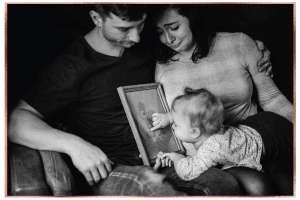Birth is a beautiful, unpredictable experience with the power to shape you in ways you can’t fully control or anticipate.
Sometimes healing from birth isn’t as straightforward as bed rest, padsicles, and spritzing your perineum. Sometimes birth injuries go a little deeper.
Today, I’m sharing the full story of my traumatic birth for the first time. It’s a story about strength, community, and coping with the unexpected, but it’s also about misaligned expectations and painful memories.
(If you’re still reeling from a traumatic birth experience, some material in this article may be distressing! If you don’t feel inspired and uplifted by birth stories at the moment, that’s totally normal. Read no further!)
I hope my story encourages you to share your own birth stories with others and to fully embrace the highs and lows of your birth experience.

This site contains affiliate links, meaning that we earn a small commission for purchases made through our site. We only recommend products we personally use, love, or have thoroughly vetted.
- A Natural-Minded Mama And Her Unexpected Hospital Induction
- Arriving At The Hospital
- Getting Induced And Coping With Labor
- Confined To Bed And Feeling Out Of Control
- An Epidural and Vaginal Delivery
- Processing the Trauma Of Birth
- Dealing With Birth Trauma While Welcoming Baby #2
- Overcoming My Sense Of Failure And Telling My Birth Story
- A Few Lessons On Healing From Birth Trauma
A Natural-Minded Mama And Her Unexpected Hospital Induction
When the due date passed for my second child and rainbow baby, I had just completed my yoga teacher training. I was steeped in the love and support of my fellow yoga students, family, friends, and even my coworkers. I was glowing.
I had done all the things a hippie mom like myself needed to do to prepare for labor. (Or so I thought). I ate well, exercised, meditated, painted my nursery in low-toxicity paints, stuffed myself with dates and raspberry tea, and took detailed notes at my childbirth education class with my doula.
When I received the news from my nurse midwife that I would need to be induced, I was crestfallen. My brain understood I was a week past my due date and at higher risk for complications thanks to a single umbilical artery diagnosis.
An induction was the logical next step, but I couldn’t help feeling deeply disappointed.
I felt so prepared for a natural delivery at my local hospital, and now, here I was doomed to experience the “cascade of interventions.” (That’s when one procedure used to speed labor results in many additional procedures.)
It was a real gut punch. I realize many mothers consider an induction perfectly normal, maybe even ideal. There’s no judgment here, but I saw induction as an obstacle to getting the natural, unmedicated birth I envisioned.
You see, I had done all the physical work of labor prep but none of the emotional work. I rejected my birth story before it even unfolded.
Arriving At The Hospital
On the day we were called to the hospital for my induction, I read aloud from Awakening Shakti: The Transformative Power of The Goddesses of Yoga and summoned as much divine feminine energy as I could muster for what would become a difficult and life-changing experience.
“The power behind breath is the expression of the feminine…” I repeated, staring expectantly out the car window.
After the standard intake process, one of a rotating set of midwives came in to insert a foley bulb or balloon catheter. This particular midwife decided to leave her bedside manner at home, roughly inserting the catheter and inflating the bulb without warning me. I was taken aback by the pain.
I had requested this procedure be done first before starting Pitocin. I was concerned about the frequency and intensity of contractions with Pitocin and hoped to avoid it altogether. Unfortunately, after only 3 hours with no signs of labor progression, the midwives recommended starting a traditional induction.
Getting Induced And Coping With Labor
Looking back, I’m certain I was afraid of what would come next, but I had a fantastic birth team to keep me going. My doula turned off any harsh fluorescence, set up my labor playlist, added warm fairy lights to the bathroom, and kept a diffuser stocked with relaxing essential oils. She supported my husband and Mom too, helping them stay calm and focused.
We also had one lovely traveling hospital nurse who had worked in birth centers across California. I’ll always remember her professional care, how she asked me for my consent every time she touched me, and how willing she was to take any and all of my questions. Wherever you are now, thank you.
After the induction, the contractions came on fairly quickly. No doubt they were painful and frequent, but I managed them well by bouncing and rocking on a yoga ball and taking long, controlled breaths to stimulate my parasympathetic nervous system (A trick I learned through lots of yoga!)
I felt in control again. I could have stayed on the ball that way for hours and hours. I learned later on that during that period of my labor, I was practicing the 3 R’s of coping–rest, rhythm, and ritual. Here’s a video describing the technique from the godmother of doulas, Penny Simkin.
Confined To Bed And Feeling Out Of Control
Unfortunately, as part of my induction I was required to have continuous fetal monitoring–a device worn like a belt around my belly. My bouncing and rocking kept shifting the monitor and eventually, the nursing staff told me I would have to stay still in bed.
Once I was confined to bed, I nearly broke in half. Both emotionally and physically, the contractions overwhelmed me. Instead of resting in between them, I tensed up even further.
Every fiber of my being wanted off that bed, but I couldn’t move too much or another annoyed, sleep-deprived nurse would show up to adjust my monitor.
Even surrounded by my loved ones, I felt so hopeless and alone. It’s a memory I’ve turned away from so consistently I don’t even know what is real or imagined. Returning to it now is a struggle. It’s an emotional wound that I’m slowly working to heal.
The only relief I had was my sweet doula who massaged my hips and provided counterpressure to each contraction. She must have been at it for hours, bless her.
Despite her efforts, laboring in bed was too stressful. My labor stalled, and the midwives grew increasingly worried about my lack of progress and the length of my labor. I was also approaching the 24-hour mark after my water had broken, leading to a higher risk of infection for our baby.
Eventually, the sweet traveling nurse came in and laid it all out for me plainly–your midwives say you can either accept an epidural or they’ll require a cesarean section right away. Given a choice like that, I requested the epidural.
An Epidural and Vaginal Delivery
After the epidural was administered, my labor was a hazy blur. I drifted in and out of sleep, finally getting the rest I needed to carry on. I can’t tell you how many hours passed. I couldn’t tell you even minutes after I pushed our son into the world. Only afterward did my husband say I’d been in labor for 37 hours.
Feverish from the epidural, I wasn’t allowed to hold my newborn son for more than a couple minutes. I asked my husband to hold him, and while my mother and husband oohed and awed over our precious little baby, my doula brought over some graham crackers and cold apple juice. It was the best-tasting food I’d ever eaten.
I was so overjoyed to finally meet my son, so confused about the labor I had just experienced, and too exhausted to even tell the midwives I could feel every prick of the needle as they sewed up a few first-degree tears.
I knew I was a mess, but cleaning up this mess would have to wait.
Processing the Trauma Of Birth
I put off telling this story for almost 4 years. Secretly, I refused to let the pain and disappointment of my less-than-ideal birth define me. At times it felt like it happened to someone else.
I didn’t have time for introspection anyway. Following my labor, I fell straight into a quagmire of hormones, marathon breastfeeding, pumping, bottles, diapers, and 12 am bedtimes. And what about my rapidly deteriorating marriage, or the giant blood clots spelunking out of my vagina? Where does a new mother put her attention?
Dealing With Birth Trauma While Welcoming Baby #2
When we conceived our second baby, I was acutely aware of the trauma hanging over my second pregnancy. I knew I needed to pull the venom of these memories out before I could relax and fully experience labor again. I didn’t realize how much pain I was holding onto until I watched the television show Fleishman Is In Trouble.
In one scene, a terrified laboring mother (expertly played by Claire Danes) has her membranes stripped and water broken without her consent by her physician. The violation, the loss of control, sends her spiraling. The pain stalks her for years, ultimately leading to a psychotic episode that puts her work, her marriage, and her relationship with her two children in jeopardy.
I cried, in secret, for weeks after seeing this scene. I knew deep in my soul what this character was feeling. I too didn’t want to own up to what I perceived for so long as my failure. My failure to plan, to make dramatic changes to my birth preparation, to try every possible avenue to avoid the type of hospital birth I dreaded: an induction with an epidural.
Overcoming My Sense Of Failure And Telling My Birth Story
When my mind turned to my birth, the miserable feeling I felt was shame. I was a sham, a fraud, and a failure. I was embarrassed to be complaining about anything when I had a healthy baby, a supportive husband, and all the comforts of my upper-middle class life.
One thing became clear. I needed to tell the whole story, to get closer to my trauma so I could finally let it go.
The greatest sources of our suffering are the lies we tell ourselves.
– Bessel van der Kolk, The Body Keeps The Score: Brain, Mind, and Body In The Healing Of Trauma
The more I explored my feelings, the more I re-discovered the positive and emotionally profound moments of my birth that made it worth remembering:
I had a supportive birth team, worked with some great nurses, and held my precious child in my arms for the first time. My husband stepped up for me in ways I could never imagine. I was so freaking strong during so many difficult moments. Heck, I even ate a really good salad from the hospital cafeteria before I got induced.
I am starting to see the good and the bad all jumbled together, and it’s beautiful. This is my birth story, y’all. This one’s mine.
A Few Lessons On Healing From Birth Trauma
If you’ve experienced pregnancy, labor, or postpartum trauma, you are not alone. One-third of women experience some trauma while giving birth.
At Undefining Motherhood, we hold space for each person’s journey to motherhood.
We support you through the losses and celebrate your wins. I hope my story inspires you to seek your own wellness and healing. You are worth it!
While I’m still working through my own trauma, I would love to conclude with some helpful advice I’ve received from other mothers, midwives, doulas, and counselors on both limiting birth trauma and healing from birth trauma. I hope it helps you, too:
- Be open to what birth brings you. It’s ok to have a vision for your birth, but consider ways you can be supported and cared for if your birth plan has to change.
- Listen to different birth stories but say no to hearing someone’s “horror” story. The Birth Hour podcast features a full range of birth experiences and philosophies.
- Have a birth team you love and trust (partner, friend, doula). Don’t be afraid to exclude family members who bring fear, uncertainty, or negativity to your birth.
- Recognize birth trauma and talk to someone about it. Find a therapist who specializes in labor and postpartum trauma or a counselor trained in Birth Story Medicine.
- Remember you get to decide what’s most important about your birth. Loving and accepting your birth story is worth the emotional heavy lifting.
If you’re comfortable sharing, what parts of your birth story are you still processing? How are you coping with them?








